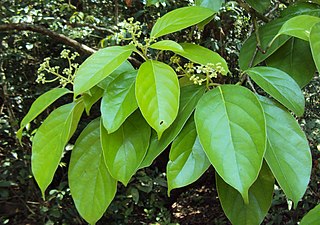
Garcinia is a genus of flowering plants in the family Clusiaceae native to Asia, America, Australia, tropical and southern Africa, and Polynesia. The number of species is disputed; the Kew Gardens recognise up to 400. Commonly, the plants in this genus are called saptrees, mangosteens, garcinias, or monkey fruit.
Crudia scortechinii is a species of plant in the family Fabaceae. It is a tree endemic to Peninsular Malaysia. The wood of trees of this genus in called "Babi Kurus" in local language. This plant is threatened by habitat loss due to harvesting of the trees.
Diplodiscus hookerianus is a species of flowering plant in the family Malvaceae sensu lato or Tiliaceae. It is a tree endemic to Peninsular Malaysia.

Diplodiscus is a genus of flowering plants in the family Malvaceae sensu lato or Tiliaceae.
Diplodiscus paniculatus is a species of flowering plant in the family Malvaceae sensu lato or Tiliaceae. It is found only in the Philippines. It is threatened by habitat loss.
Garcinia scortechinii is a species of flowering plant in the family Clusiaceae. It is a tree found in Peninsular Malaysia and Singapore.
Aglaia scortechinii is a species of plant in the family Meliaceae. It is found in Brunei, Indonesia, and Malaysia.
Ardisia scortechinii is a species of plant in the family Primulaceae. It is a tree endemic to Peninsular Malaysia.
Castanopsis scortechinii is a species of plant in the family Fagaceae. It is a tree endemic to Peninsular Malaysia. It is threatened by habitat loss.
Syzygium scortechinii is a species of plant in the family Myrtaceae. It is found in Malaysia and Singapore.
Gordonia scortechinii is a species of plant in the family Theaceae. It is a tree endemic to Peninsular Malaysia. It is threatened by habitat loss.
Hydnocarpus scortechinii is a species of plant in the family Achariaceae. It is a tree endemic to Peninsular Malaysia. It is threatened by habitat loss.
Knema scortechinii is a species of plant in the family Myristicaceae. It is a tree endemic to Peninsular Malaysia.
Kopsia scortechinii is a species of plant in the family Apocynaceae. It is a tree endemic to Peninsular Malaysia.
Litsea scortechinii is a species of plant in the family Lauraceae. It is a tree endemic to Peninsular Malaysia. It is threatened by habitat loss.

Mastixia is a genus of about 19 species of resinous evergreen trees, usually placed in the family Cornaceae. Its range extends from India through Southeast Asia and New Guinea to the Solomon Islands. Mastixia species have alternate or opposite simple broad leaves, many-flowered inflorescences, and blue to purple drupaceous fruits.
Phoebe scortechinii is a species of plant in the family Lauraceae. It is a tree endemic to Peninsular Malaysia.
Vatica scortechinii is a species of plant in the family Dipterocarpaceae. It is a tree endemic to Peninsular Malaysia. It is a critically endangered species threatened by habitat loss.
As of July 2016, the International Union for Conservation of Nature (IUCN) lists 238 conservation dependent species. 0.29% of all evaluated species are listed as conservation dependent. The IUCN also lists seven subspecies and five varieties as conservation dependent.
Grevillea scortechinii, commonly known as the black grevillea, is a shrub which is endemic to Queensland and New South Wales in Australia.



